|
|
|||||||||||||||||||
|
Pevsner described as “remarkable although poorly preserved”. Most conspicuous is a very chivalric-looking St George. St Francis is here too, feeding the birds, a most unusual subject although you can see him “receiving the stigmata” (the wounds of Christ) at Slapton in Northamptonshire where the paintings really are remarkable. More interesting to me was the set of six floor tiles with roundel pictures preserved in the chancel. In fact, each “roundel” is a product of five pieces with decoration in the corner areas. These too are thirteenth century. They are the product of the dissolved Chertsey Abbey in Surrey where a number of tiles were discovered by workmen clearing part of the site in 1854 The foreman ordered them to be smashed up as the workmen were spending too much time looking at them! It was not until 1922 that the original kiln was found, confirming that the tiles were locally produced and had not been imported. Remarkably, the surviving Chertsey set of twelve tiles showed scenes from the Third Crusade two of them showing Richard the Lionheart slaying Salah uh-din (Saladin to you) in a single combat that never happened. Those two tiles are now in the British Museum. Little Kimble Church was owned by Chertsey Abbey, so the likelihood is that what we see at Little Kimble Church was placed here at the time and not, as has been suggested elsewhere, looted from the suppressed abbey. As with the abbey itself, the tiles depict secular images, in this case of Arthurian romances. It seems the Chertsey monks and artists had a penchant for tales of derring do, perhaps conflating the elusive legends of Arthur with the romanticised accounts of the martial but deeply flawed Richard. To finish off an unexpected little mediaeval art gallery there is a nice selection of mediaeval stained glass with heraldic devices. All in all, this is a very satisfying church to visit and is so easily combined with Great Kimble just up the road with its fine Aylesbury font. If you live in the area, what are you waiting for? |
 |
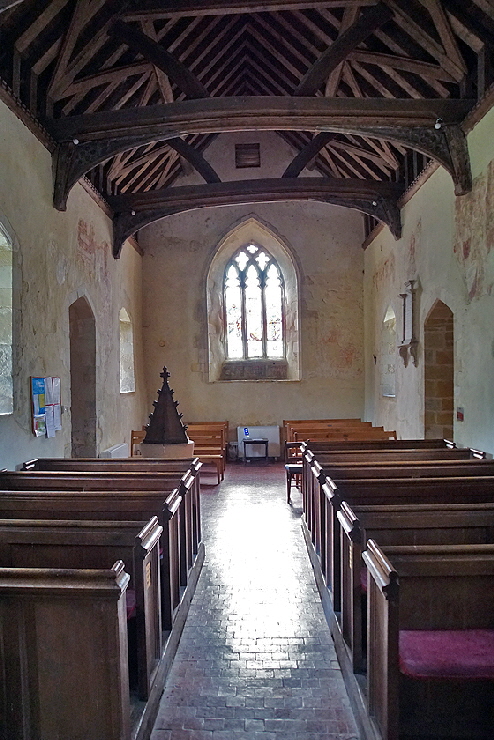 |
||||||||||||||||||||||||||||||||||||||||||
 |
|||||||||||||||||||||||||||||||||||||||||||
|
Left Upper: Looking towards the east. The chancel arch is broad and slightly askew. Note the wall paintings. Left Lower: The pretty timber roof. Right: Looking towards the west. |
|||||||||||||||||||||||||||||||||||||||||||
 |
|||||||||||||||||||||||||||||||||||||||||||
 |
|||||||||||||||||||||||||||||||||||||||||||
|
Left: The very fine St George and the Princess. He is unusual in not sitting on a horse and there is no dragon. We are so used to St George that we forget why he was (allegedly) killing a dragon in the first place. George was an officer in the Roman army. At a town called Silene (in modern Libya) the king was about to his sacrifice his daughter to placate a dragon who had camped outside the city wall. George agrees to kill the dragon - boy, the self-confidence - if the entire town agrees to be baptised. So another bonkers story. It is quite unpleasant too, isn’t it? We are used to the early Christians inventing these ridiculous stories: the boundless imaginations of “kings” to find horrible ways to kill Christian martyrs who cling to their faith through the most horrible privations. What sort of fevered imaginations invented this stuff? And in the St George stuff we have a whole city being blackmailed into baptism. “Never mind what they believe, just get ‘em in the river: we’ve got recruitment targets to meet”. How odd that all these “martyrs” all still revered by the Roman Catholic Church. No mediaeval artist I have ever seen has ever known that George was a Roman. So here he is fetchingly dressed in a Templar-like outfit, all plate armour and chain mail! The inscription George was added later. Right: The fashionably elegant princess. |
|||||||||||||||||||||||||||||||||||||||||||
 |
 |
 |
|||||||||||||||||||||||||||||||||||||||||
|
Left: This is a rare representation of St Bernard on the south side of the church. This, unlike Georgy-Porgy and the rest, was a real historical figure. living 1090-1153. Bernard of Clairvaux (who was not Swiss, by the way!) was a giant of the early church. in 1110 he joined the monastery at Citeaux. He was one of four major contributors (another was the Englishman, Stephen Harding) to the foundation of the Cistercian Order - the White Monks - which was determined to more strictly adhere to the original Order of St Benedict. Cistercian derives from Latin name for for Citeaux - Cistercium. He also contributed to the drawing up of the order of the Knights Templar and was a powerful advocate of the Crusades. Bernard became a confidante and advisor to Popes and was enormously influential. Indeed, the Cistercian Order became a favourite of the European nobility because of its perceived strictness. It strikes me that Bernard’s presence here might reflect the very Templar-looking St George. The Church Guide favours St John but doesn’t say why. Centre: In a window rebate on the north side is this damaged representation of St Francis talking to the birds. Right: An unidentified female figure. |
|||||||||||||||||||||||||||||||||||||||||||
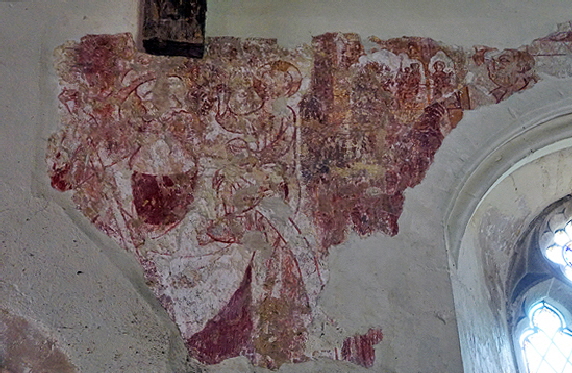 |
 |
||||||||||||||||||||||||||||||||||||||||||
|
Left: St Christopher in his traditional place opposite the south door with Christ in his arms. Right: The only clear part of this is the man on the right holding a woman by her hair and about to bring down his sword. This is St Catherine who was beheaded after the wheel upon which she was to be killed broke. |
|||||||||||||||||||||||||||||||||||||||||||
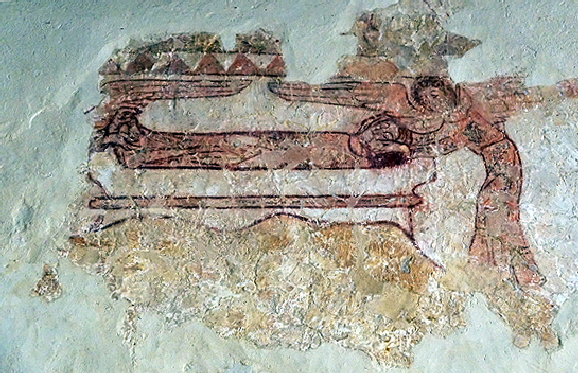 |
|||||||||||||||||||||||||||||||||||||||||||
 |
|||||||||||||||||||||||||||||||||||||||||||
|
Left: St Catherine again, this time being borne by angels to Mount Sinai. Right: The west wall has, according to the Church Guide, a doom painting. For the life of me I can’t make it out but here are a couple of women from it. They don’t look too happy so I suppose it was thumbs down for them? |
|||||||||||||||||||||||||||||||||||||||||||
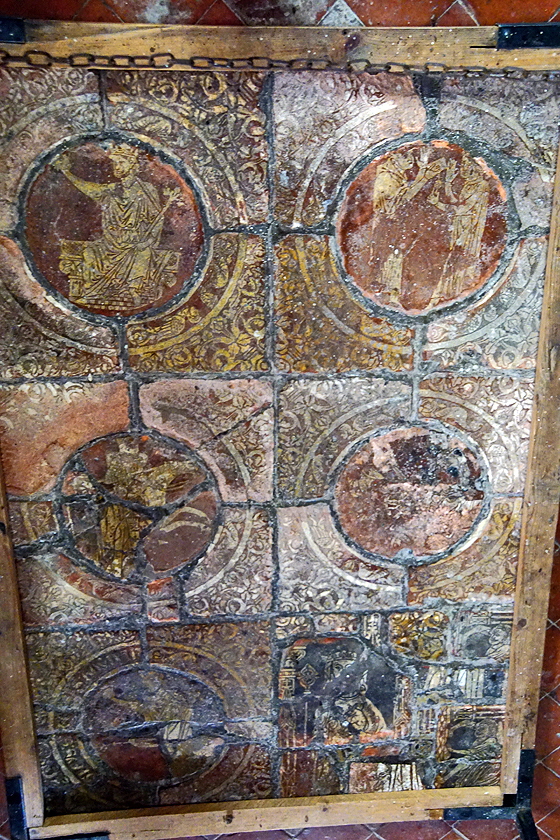 |
 |
||||||||||||||||||||||||||||||||||||||||||
 |
 |
 |
|||||||||||||||||||||||||||||||||||||||||
 |
|||||||||||||||||||||||||||||||||||||||||||
 |
|||||||||||||||||||||||||||||||||||||||||||
|
The floor tiles. They supposedly represent the legend of Tristan and Iseult (or Isolde) but I am not sufficiently familiar with the story to be able to comment. In the story Tristan is sent to Ireland to bring back Iseult who is to be wed to his uncle King Mark of Cornwall. They ingest a love potion en route and fall in love with each other. King Mark is unaware of the affair. Tristan, despite his treachery in love is devoted to King Mark as a subject. It all parallels the equally legendary King Arthur - Guinevere - Lancelot love triangle. I presume that the mounted knight (top right) is Tristan. There seem to be two very similar representations of the cuckolded king. Bottom left a man - a monk?- gives a book to a woman - Iseult? Naughty Iseult is in the tile bottom right, holding a squirrel. Squirrels were frequently kept as pets in mediaeval England and even beyond.. Note the inscriptions on some the roundels. Note also the decorations in the surrounding circles where there are several fantastic figures. |
|||||||||||||||||||||||||||||||||||||||||||
 |
 |
 |
 |
||||||||||||||||||||||||||||||||||||||||
|
Left: The north side of the chancel has this lancet window. Note the rebates to left and right into which a shutter would have been fitted. Second Left: The English arms of three leopards quartered with the French fleurs de lys, maintaining the long-nurtured conceit that the kings of England were the rightful kings of France. Note more fleurs de lys in the surrounding while glass. Centre Right: We can see more French fleurs de lys in this glass but it looks like the pieces have been reset. Right: Another heraldic piece. |
 |
 |
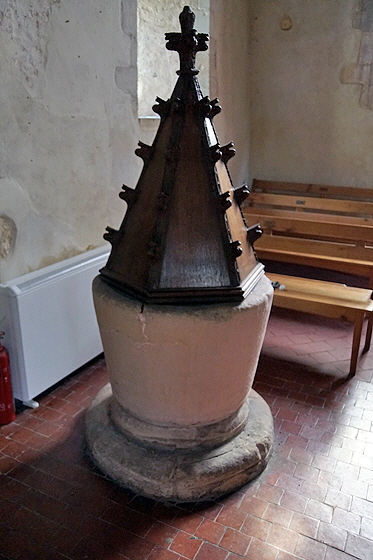 |
|
Left: The three leopards of England in close-up. Centre: One of the heraldic windows. Right: The plain Norman tub font, possibly from the Norman castle chapel. |
 |
 |
|
Left: The mediaeval glass at the top of one of the north windows. Right: The north side. |
|
|
|
|
I hope you have enjoyed this Page and, perhaps, many more besides. Could you help me to make it better still and preserve its future? |
|
You may View or Download a .pdf Version of this Page Below |
|
|
|||
